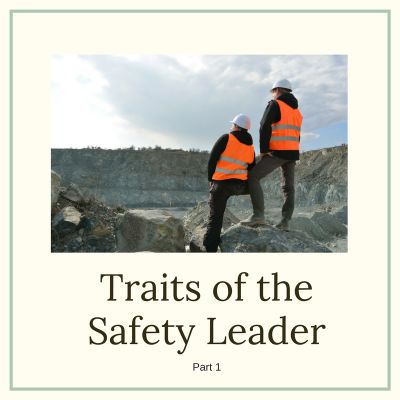Traits of Safety Leadership - Part 1
Do you have the traits of a safety leader? Use this post as a self-assessment tool.
 Over the past couple of years, I have written much about safety leadership but not in the sense of a management or supervisory position. The safety leadership that I subscribe to is a personal one.
Over the past couple of years, I have written much about safety leadership but not in the sense of a management or supervisory position. The safety leadership that I subscribe to is a personal one.
Leadership requires no title or position. In fact, some of the best workplace leaders are just ordinary employees who happen to possess certain traits that causes others to look up to them and to seek their advice. They are the people who tend to make the first move and ask the first questions. They do not let their ego or uncertainty stand in the way of doing the job right. They ask the questions to be certain of what is expected of them and they ensure they have right information to make good decisions, especially where their own safety is concerned.
Leaders are not managers necessarily although some management people may possess great leadership skills. Other managers, supervisors or safety people may be void of the traits of leadership but still have the authority of their positions. Having authority, a title or a position does not make you a leader. It makes you a manager. Not the same.
There is a vast difference between people seeking out your opinion based on your authority and those who might seek your counsel because of your ability to be focused on helping others to achieve better.
Do you have the traits of a safety leader? Why not use this series of posts on safety leadership as a self-assessment tool to determine how well you score? We feature just a few traits each post to allow you to determine how well you're doing. This post is not the definitive and exhaustive list of traits of safety leaders. There are many more than those listed here. Here are the first three traits of safety leaders:
1Self-awareness. This may not be one of the big leadership qualities like vision or decisiveness but without self-awareness, those big traits falter. A leader needs to know where there are gaps in his or her skill-set. Pretending that gaps don't exist or papering over them is dangerous. And it's a lie. Self-awareness is critical to safety leadership. Front-line employees can benefit more from a person who knows that he doesn't know it all than from someone who pretends to know it all. In safety, following someone who pretends to know it all can get you hurt. I would like to point out here that it was my wife who suggested this item for the list of leadership traits because, as it has become quite evident, I don't know it all.
2Decisiveness. It can, and does, save lives. The media regularly say things like, "the quick and decisive actions averted a tragedy." And in the safety realm, decisiveness is key. Taking too long to make a decision can have dire consequences. Making decisions too quickly without weighing options can be just as dangerous. Saying yes so as to avoid conflict is not decisiveness. Saying no as a caution because you are afraid of being wrong is also not decisiveness. Decisiveness in safety leadership is about what is best for people, not just for you. Crews look up to and follow leaders. Crews may tolerate indecisive managers and supervisors but likely won't trust them. Decisive ability rests largely on your willingness to truthfully be self-aware of strengths and gaps. And then making good decisions for others; decisions you are willing to stand behind.
3Vision. Employees will buy-in to a leader's vision. They will have a difficult time buying-in to someone who spouts only rules and procedures. With a vision, a safety leader can clearly communicate why we're here and what we're doing. In addition, he or she can help others to see the vision of "why" we are doing it this way. A safety leader's vision extends to how they view their people. If they view their people as those who must be tightly controlled for fear they will make a mistake, that is is not a leadership vision. That is poor management. A safety leader can see the strengths and gaps in each employee and wants to help each of them to get better in performance. When each member of the team gets better, the team excels. A good visionary safety leader wants to ensure that his or her people develop the skills (including vision) to become leaders themselves.
 Safety leaders are outward-focused. They have to be. The safety of their crews depend upon it. And to be a safety leader requires far more than quoting chapter and verse from the safety rules. Anyone can do that. But to communicate at a level where people can not only hear the words you say, but feel the connection behind those words, well, that's safety leadership. Safety leadership is not about the position you hold, but about the difference you make and the people you help.
Safety leaders are outward-focused. They have to be. The safety of their crews depend upon it. And to be a safety leader requires far more than quoting chapter and verse from the safety rules. Anyone can do that. But to communicate at a level where people can not only hear the words you say, but feel the connection behind those words, well, that's safety leadership. Safety leadership is not about the position you hold, but about the difference you make and the people you help.
Kevin Burns has authored ten books on human performance and safety, including his most recent release, PeopleWork - The Human Touch in Workplace Safety. Buy it now on Amazon. Then, consider bringing Kevin's consulting expertise to your company or have him speak at a safety event.
©2017 ZeroSpeak Corporation and Kevin Burns.
No part of this post may be reproduced without the expressed consent of the author.


